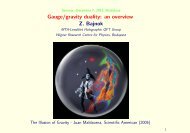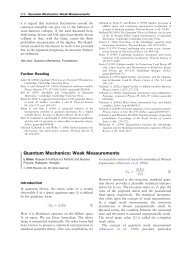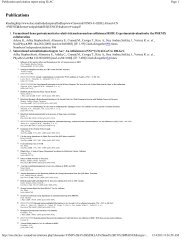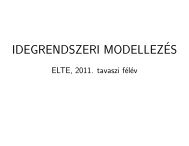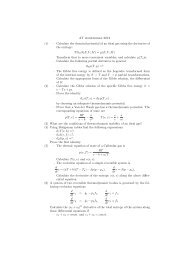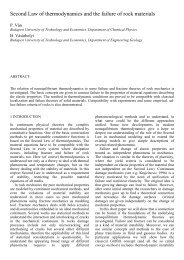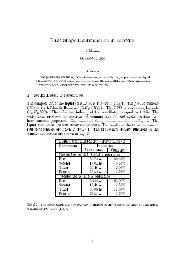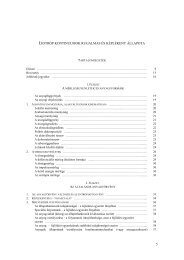hungarian scientists in the us - Columbia University
hungarian scientists in the us - Columbia University
hungarian scientists in the us - Columbia University
You also want an ePaper? Increase the reach of your titles
YUMPU automatically turns print PDFs into web optimized ePapers that Google loves.
László Záborszky<br />
and Behavioral Neuroscience at Rutgers<br />
<strong>University</strong> <strong>in</strong> 1993, where he was<br />
promoted to Professor I with tenure<br />
<strong>in</strong> 2004. He spent short sabbaticals <strong>in</strong><br />
<strong>the</strong> Max Planck Institute for Biophysical<br />
Chemistry <strong>in</strong> Gott<strong>in</strong>gen, Germany<br />
(1976), <strong>in</strong> <strong>the</strong> Montreal General Hospital,<br />
Canada (1986), at <strong>the</strong> National<br />
Institute for Physiological Sciences,<br />
Okazaki, Japan (2000), <strong>in</strong> <strong>the</strong> Vogt<br />
Institute for Bra<strong>in</strong> Research <strong>in</strong> Duesseldorf<br />
(2000) and <strong>in</strong> <strong>the</strong> Institute<br />
of Neuroscience and Biophysics,<br />
Research Center Juelich, Germany<br />
(2005). He published 113 scientific<br />
papers, <strong>in</strong>clud<strong>in</strong>g book chapters<br />
and a monograph on hypothalamic<br />
connections (Spr<strong>in</strong>ger, 1982). His<br />
anatomical studies <strong>in</strong>spired research<br />
<strong>in</strong> many laboratories as reflected <strong>in</strong><br />
<strong>the</strong> high number of citations (over<br />
6200) that his papers received. He is<br />
co-editor of Neuroanatomical Tract-<br />
Trac<strong>in</strong>g Methods 2 (Plenum, 1989)<br />
and lead editor of Neuroanatomical<br />
Tract-Trac<strong>in</strong>g 3: Molecules, Neurons,<br />
Systems (Spr<strong>in</strong>ger, 2006). He held<br />
more than 75 <strong>in</strong>vited lectures at vario<strong>us</strong><br />
<strong>in</strong>ternational conferences and <strong>in</strong>stitutions.<br />
He has served on vario<strong>us</strong><br />
<strong>in</strong>ternational and federal scientific<br />
advisory boards and chaired and organized<br />
numero<strong>us</strong> symposia <strong>in</strong> <strong>the</strong> United<br />
States and <strong>in</strong> Hungary. He advised<br />
many (46) Undergraduate, Graduate<br />
Students and Postdoctoral Fellows He<br />
is recipient of numero<strong>us</strong> private and<br />
federal research grants total<strong>in</strong>g over<br />
9.8 million dollars. He is Found<strong>in</strong>g<br />
Basal Forebra<strong>in</strong>: Anatomy to Function<br />
The basal forebra<strong>in</strong> (BF) comprises<br />
functionally and neurochemically<br />
heterogeneo<strong>us</strong> cell populations along<br />
<strong>the</strong> medial and ventral surfaces of<br />
<strong>the</strong> forebra<strong>in</strong> that are implicated <strong>in</strong><br />
vario<strong>us</strong> functions, <strong>in</strong>clud<strong>in</strong>g cortical<br />
activation, sensory process<strong>in</strong>g, memory<br />
and attention but <strong>the</strong> functional<br />
details are not well understood due<br />
to <strong>the</strong> anatomical complexity of this<br />
region. Chol<strong>in</strong>ergic cells, which are<br />
widely distributed <strong>in</strong> <strong>the</strong> BF, provide<br />
<strong>the</strong> majority of acetylchol<strong>in</strong>e found <strong>in</strong><br />
<strong>the</strong> cerebral cortex. Patients with Alzheimer’s<br />
disease (AD) have a significant<br />
decrease of acetylchol<strong>in</strong>e <strong>in</strong> <strong>the</strong><br />
cortex and show pathological changes<br />
<strong>in</strong> chol<strong>in</strong>ergic basal forebra<strong>in</strong> neurons.<br />
Although much controversy rema<strong>in</strong>s<br />
as to <strong>the</strong> primary target of this disease,<br />
our recent work by mapp<strong>in</strong>g <strong>the</strong><br />
chol<strong>in</strong>ergic BF compartments to standardized<br />
MRI space provided <strong>the</strong> necessary<br />
foundation to <strong>in</strong>vestigate how<br />
structural changes <strong>in</strong> <strong>the</strong> BF correlate<br />
to cognitive symptoms dur<strong>in</strong>g age<strong>in</strong>g<br />
and AD. We found that patients with<br />
mild cognitive impairment (MCI) –<br />
prodromal phase of AD- similar to advanced<br />
AD, exhibit significant volume<br />
Laszlo Zaborszky, is Professor of Neuroscience<br />
at Rutgers-Newark, NJ. He<br />
received his MD at Semmelweis <strong>University</strong><br />
with Sub A<strong>us</strong>picis Rei Publicae<br />
Popularis (1970), and his PhD<br />
(1981) and Doctor of Science (DSc,<br />
2000) from <strong>the</strong> Hungarian Academy<br />
of Sciences. He jo<strong>in</strong>ed <strong>the</strong> faculty of<br />
<strong>the</strong> Department of Anatomy, Semmelweis<br />
<strong>University</strong> headed by J. Szentagothai<br />
<strong>in</strong> 1969 where he worked<br />
until 1981. He was also appo<strong>in</strong>ted Assistant<br />
Professor <strong>in</strong> <strong>the</strong> Department of<br />
Anatomy at <strong>the</strong> <strong>University</strong> of Wurzburg,<br />
Germany (1973-1974). In 1981<br />
he was <strong>in</strong>vited to jo<strong>in</strong> <strong>the</strong> laboratory Editor-<strong>in</strong>-Chief, Bra<strong>in</strong> Structure and<br />
of Professor Heimer at <strong>the</strong> <strong>University</strong> Function (www.spr<strong>in</strong>ger.com/429).<br />
of Virg<strong>in</strong>ia, Charlottesville, where he He was elected foreign member of<br />
was appo<strong>in</strong>ted Associate Professor of <strong>the</strong> Hungarian Academy of Sciences<br />
Neurology, with a jo<strong>in</strong>t appo<strong>in</strong>tment (2007) and was awarded Dr. habil.<br />
<strong>in</strong> <strong>the</strong> Department of Neurosurgery <strong>in</strong> of Semmelweis <strong>University</strong> (2004),<br />
1986. Later, he served <strong>the</strong>re as Director<br />
of <strong>the</strong> Laboratory of Cellular and recently formed New York Hungarian<br />
Hungary. He is Vice-President of <strong>the</strong><br />
Molecular Neuroanatomy (1992). He Scientific Society. URL: http://zlab.<br />
moved to <strong>the</strong> Center for Molecular rutgers.edu/<br />
3626126 25 26<br />
reduction <strong>in</strong> <strong>the</strong> nucle<strong>us</strong> basalis that is<br />
correlated with memory deficits.<br />
By apply<strong>in</strong>g vario<strong>us</strong> computational<br />
anatomical methods, we have shown<br />
that chol<strong>in</strong>ergic and non-chol<strong>in</strong>ergic<br />
neurons <strong>in</strong> rodents show small-scale<br />
associations <strong>in</strong> <strong>the</strong> form of regionally<br />
specific cell cl<strong>us</strong>ters <strong>in</strong> <strong>the</strong> entire chol<strong>in</strong>ergic<br />
BF space. The connectional<br />
pattern of <strong>the</strong>se cell cl<strong>us</strong>ters suggest<br />
that <strong>the</strong>y may serve an associational<br />
function that <strong>in</strong>volves transmitt<strong>in</strong>g<br />
<strong>in</strong>formation from specific subcortical<br />
locations to a small subset of cortical<br />
areas that most likely are <strong>in</strong>terconnected.<br />
This mechanism may support<br />
<strong>in</strong>teractions between cortical and subcortical<br />
attentional networks. Parallel<br />
to network reconstructions, s<strong>in</strong>gle cell<br />
analysis <strong>in</strong> vivo and <strong>in</strong> vitro began to<br />
shed light on <strong>the</strong> elementary circuit of<br />
this region. These results will lead to<br />
more realistic animal models for address<strong>in</strong>g<br />
function <strong>in</strong> behavioral studies.<br />
Concomitantly, it will facilitate<br />
<strong>the</strong> understand<strong>in</strong>g of <strong>the</strong> aberrant process<strong>in</strong>g<br />
<strong>in</strong> basalo-cortical networks<br />
and may help <strong>the</strong> development of new<br />
treatment strategies to ameliorate <strong>the</strong><br />
cognitive symptoms <strong>in</strong> AD.



